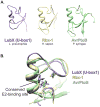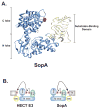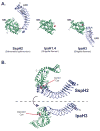Hijacking the host ubiquitin pathway: structural strategies of bacterial E3 ubiquitin ligases
- PMID: 20036613
- PMCID: PMC2822022
- DOI: 10.1016/j.mib.2009.11.008
Hijacking the host ubiquitin pathway: structural strategies of bacterial E3 ubiquitin ligases
Abstract
Ubiquitinylation of proteins is a critical mechanism in regulating numerous eukaryotic cellular processes including cell cycle progression, inflammatory response, and vesicular trafficking. Given the importance of ubiquitinylation, it is not surprising that several pathogenic bacteria have developed strategies to exploit various stages of the ubiquitin pathway for their own benefit. One such strategy is the delivery of bacterial 'effector' proteins into the host cell cytosol, which mimic the activities of components of the host ubiquitin pathway. Recent studies have highlighted a number of bacterial effectors that functionally mimic the activity of eukaryotic E3 ubiquitin ligases, including a novel structural class of bacterial E3 ligases that provides a striking example of convergent evolution.
Copyright 2009 Elsevier Ltd. All rights reserved.
Figures



Similar articles
-
Modification of the host ubiquitome by bacterial enzymes.Microbiol Res. 2020 May;235:126429. doi: 10.1016/j.micres.2020.126429. Epub 2020 Feb 11. Microbiol Res. 2020. PMID: 32109687 Free PMC article. Review.
-
A pathogen type III effector with a novel E3 ubiquitin ligase architecture.PLoS Pathog. 2013 Jan;9(1):e1003121. doi: 10.1371/journal.ppat.1003121. Epub 2013 Jan 24. PLoS Pathog. 2013. PMID: 23359647 Free PMC article.
-
Bacterial E3 ligase effectors exploit host ubiquitin systems.Curr Opin Microbiol. 2017 Feb;35:16-22. doi: 10.1016/j.mib.2016.11.001. Epub 2016 Nov 28. Curr Opin Microbiol. 2017. PMID: 27907841 Review.
-
A family of Salmonella virulence factors functions as a distinct class of autoregulated E3 ubiquitin ligases.Proc Natl Acad Sci U S A. 2009 Mar 24;106(12):4864-9. doi: 10.1073/pnas.0811058106. Epub 2009 Mar 9. Proc Natl Acad Sci U S A. 2009. PMID: 19273841 Free PMC article.
-
Ubiquitin Ligases: Structure, Function, and Regulation.Annu Rev Biochem. 2017 Jun 20;86:129-157. doi: 10.1146/annurev-biochem-060815-014922. Epub 2017 Mar 27. Annu Rev Biochem. 2017. PMID: 28375744 Review.
Cited by
-
Multi-omic data integration links deleted in breast cancer 1 (DBC1) degradation to chromatin remodeling in inflammatory response.Mol Cell Proteomics. 2013 Aug;12(8):2136-47. doi: 10.1074/mcp.M112.026138. Epub 2013 May 2. Mol Cell Proteomics. 2013. PMID: 23639857 Free PMC article.
-
Identification of the major ubiquitin-binding domain of the Pseudomonas aeruginosa ExoU A2 phospholipase.J Biol Chem. 2013 Sep 13;288(37):26741-52. doi: 10.1074/jbc.M113.478529. Epub 2013 Aug 1. J Biol Chem. 2013. PMID: 23908356 Free PMC article.
-
Pathogenic bacteria target NEDD8-conjugated cullins to hijack host-cell signaling pathways.PLoS Pathog. 2010 Sep 30;6(9):e1001128. doi: 10.1371/journal.ppat.1001128. PLoS Pathog. 2010. PMID: 20941356 Free PMC article.
-
Network analysis of host-pathogen protein interactions in microbe induced cardiovascular diseases.In Silico Biol. 2021;14(3-4):115-133. doi: 10.3233/ISB-210238. In Silico Biol. 2021. PMID: 35001887 Free PMC article.
-
Burkholderia pseudomallei suppresses Caenorhabditis elegans immunity by specific degradation of a GATA transcription factor.Proc Natl Acad Sci U S A. 2013 Sep 10;110(37):15067-72. doi: 10.1073/pnas.1311725110. Epub 2013 Aug 26. Proc Natl Acad Sci U S A. 2013. PMID: 23980181 Free PMC article.
References
-
- Kerscher O, Felberbaum R, Hochstrasser M. Modification of proteins by ubiquitin and ubiquitin-like proteins. Annu Rev Cell Dev Biol. 2006;22:159–180. - PubMed
-
- Hicke L, Dunn R. Regulation of membrane protein transport by ubiquitin and ubiquitin-binding proteins. Annu Rev Cell Dev Biol. 2003;19:141–172. - PubMed
Publication types
MeSH terms
Substances
Grants and funding
LinkOut - more resources
Full Text Sources
Other Literature Sources

